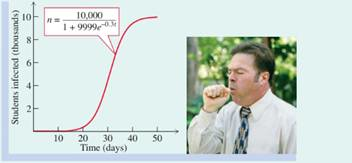
Concept explainers
LINKING concepts... For Individual or Group Explorations
The Logistic Growth Model
When a virus infects a finite population of size P in which no one is immune, the virus spreads slowly at first, then rapidly like exponential growth. Since the population is finite, the exponential growth must slow down as nearly everyone becomes infected. This type of behavior was named the logistic function or logistic curve in 1844 by Pierre Franҫ? ois Verhulst. The logistic function has the form

a) According to the model, how many people have caught the virus at time t = 0?
b) Now consider what happens when one student carrying a flu virus returns from spring break to a university of 10,000 students. For c = 0.1,0.2, and so on through c = 0.9, graph the logistic curve
y1 = 10000/ (1 + 9999e^(–cx))
and the daily number of new cases
y2= y1(x) – y1(x – 1)
For each value of c use the graph of y2 to find the day on which the flu is spreading most rapidly.
c) The Health Center estimated that the greatest number of new cases of the flu occurred on the 19th day after the students returned from spring break. What value of c should be used to model this situation? How many new cases occurred on the 19th day?
d) Algebraically find the day on which the number of infected students reached 9000.
e) The Health Center has a team of doctors from Atlanta arriving on the 30th day to help with this three-day flu epidemic. What do you think of this plan?
Want to see the full answer?
Check out a sample textbook solution
Chapter 4 Solutions
EBK COLLEGE ALGEBRA
- e). n! (n - 1)!arrow_forwardSuppose you flip a fair two-sided coin four times and record the result. a). List the sample space of this experiment. That is, list all possible outcomes that could occur when flipping a fair two-sided coin four total times. Assume the two sides of the coin are Heads (H) and Tails (T).arrow_forwarde). n! (n - 1)!arrow_forward
- Evaluate the following expression and show your work to support your calculations. a). 6! b). 4! 3!0! 7! c). 5!2! d). 5!2! e). n! (n - 1)!arrow_forwardAmy and Samiha have a hat that contains two playing cards, one ace and one king. They are playing a game where they randomly pick a card out of the hat four times, with replacement. Amy thinks that the probability of getting exactly two aces in four picks is equal to the probability of not getting exactly two aces in four picks. Samiha disagrees. She thinks that the probability of not getting exactly two aces is greater. The sample space of possible outcomes is listed below. A represents an ace, and K represents a king. Who is correct?arrow_forwardConsider the exponential function f(x) = 12x. Complete the sentences about the key features of the graph. The domain is all real numbers. The range is y> 0. The equation of the asymptote is y = 0 The y-intercept is 1arrow_forward
- The graph shows Alex's distance from home after biking for x hours. What is the average rate of change from -1 to 1 for the function? 4-2 о A. -2 О B. 2 О C. 1 O D. -1 ty 6 4 2 2 0 X 2 4arrow_forwardWrite 7. √49 using rational exponents. ○ A. 57 47 B. 7 O C. 47 ○ D. 74arrow_forwardCan you check If my short explantions make sense because I want to make sure that I describe this part accuratelyarrow_forward
 Algebra & Trigonometry with Analytic GeometryAlgebraISBN:9781133382119Author:SwokowskiPublisher:Cengage
Algebra & Trigonometry with Analytic GeometryAlgebraISBN:9781133382119Author:SwokowskiPublisher:Cengage Functions and Change: A Modeling Approach to Coll...AlgebraISBN:9781337111348Author:Bruce Crauder, Benny Evans, Alan NoellPublisher:Cengage Learning
Functions and Change: A Modeling Approach to Coll...AlgebraISBN:9781337111348Author:Bruce Crauder, Benny Evans, Alan NoellPublisher:Cengage Learning College Algebra (MindTap Course List)AlgebraISBN:9781305652231Author:R. David Gustafson, Jeff HughesPublisher:Cengage Learning
College Algebra (MindTap Course List)AlgebraISBN:9781305652231Author:R. David Gustafson, Jeff HughesPublisher:Cengage Learning College AlgebraAlgebraISBN:9781305115545Author:James Stewart, Lothar Redlin, Saleem WatsonPublisher:Cengage Learning
College AlgebraAlgebraISBN:9781305115545Author:James Stewart, Lothar Redlin, Saleem WatsonPublisher:Cengage Learning





